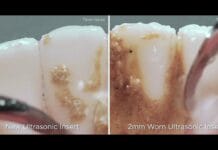Recently, I was in a situation where I thought I needed to be more of an advocate for the patient than agree with the dentist’s treatment plan. This situation tugged at my heart, and I didn’t know how to encourage a second opinion professionally.
The 69-year-old patient left the office thinking she needed five crowns. They were diagnosed a year ago, but she was also referred to a periodontist for recession and bone loss issues. She ended up having bone and tissue grafting on seven teeth, plus a cleaning. She also has splinting of teeth 19-22 and 27-30, making her periodontally compromised.
She presently only has seven restorations, so she does not have a big history of being in the dental chair. She expressed her concerns about getting a crown since she’s never had one, as well as concerns about the five overall crowns. The dentist pointed out the radiographic decay under fillings.
What Didn’t Feel Right
That’s where my concern comes in. I just didn’t see the decay. I looked again and even later asked the other hygienist, who has 20-plus years of experience, if she saw decay on the radiograph. She didn’t see anything.
My patient’s other concern was financial. She just paid off her bills a year ago and then was surprised with the $5,000 bill from the periodontist. Now, there’s almost another $5,000 for the crowns. She applied for a medical expenses credit card to help pay for these crowns since she is on a fixed income with social security.
I thought of her quite a bit over the next week, trying to figure out how to suggest a second opinion. Dentists have different philosophies, experiences, and knowledge. So another dentist may have a different treatment plan or at least not as aggressive of a treatment plan.
I am aware that I can’t diagnose, but I know what decay looks like on a radiograph. I am aware that I don’t do restorations or crowns. I’m not experienced with the clinical process once inside the tooth if something more is going on. I know I’m not a dentist − only a hygienist.
I do know from my 16 years of dental experience that the patient should be aware of all options and risks and should have a second opinion.
Seeking a Second Opinion for Myself
I asked for advice from almost any dental professional I came across and even a patient. I work in two offices. I asked the staff at my other office for advice. I even asked my other dentist to get his view. They said it’s a slippery slope, and I could expect to be fired.
I even wrote to a dental hygienist who writes for a hygiene magazine about situations like this. I have never met the hygienist, but we had about a 20-minute conversation. She suggested maybe talking with the periodontist since he would have noticed decay or recommended with the compromised periodontium that crowns would not be a good idea. However, what I learned from other dental professionals was that a referred specialist would not want to get involved in a general dentist’s treatment planning.
Other options were bounced back and forth, and all of the scenarios ended with unemployment.
I posted on a dental hygiene Facebook forum and ended up with little help. One posted: Tell the patient to shop around. Others suggested that I should just quit working for this dreadful, unethical dentist. The social media responses didn’t even answer my question about how to approach a patient about obtaining a second opinion. They angrily crucified a dentist they didn’t even know.
Throwing the Boss Under the Bus?
Unfortunately, the main consensus was that, if I say something and it gets back to the dentist, I’ll be fired. My job was on the line for advocating for the patient. I fully understood that employers would not want to be undermined, especially by someone who doesn’t do the same job.
Let me be clear. My mission was never to throw the dentist under the bus. In fact, I didn’t even want to make it sound like he was doing anything wrong. I just politely wanted to recommend a second opinion because of her situation financially and clinically.
My concern was about how to communicate that with her. Since she already left the office, I would have to call her at home. What if she called the office and said, “Your hygienist called me at home to recommend a second opinion.” That approach wouldn’t look professional, especially since this was the first time that I had seen this patient (but her husband is a regular patient, and he highly recommended her to me).
I could mail an anonymous letter or even call her anonymously? She would have had a letter to bring into the office. I didn’t want to be vague, sneaky, or appear to be against the dentist. So I just concluded that my name was going to be associated with the suggestion for a second opinion. If I get fired, I get fired.
I was having a conversation with another patient who happened to share her story about when she had foot surgery. The first physician recommended a lot clinically and financially. After the physician left the room, the assistant whispered into her ear about a second opinion.
I asked the patient what she thought about that? Was she thankful, or did she think the physician was unethical and unprofessional? She was very thankful. The second physician had a different approach and technique and was less invasive and less expensive. She said he did a great job since her foot is in tip-top shape. Even better, the treatment was less expensive. Plus, why have more work on your body than is necessary?
So, I took my cue from this patient who happened to share this story while I was struggling with a similar situation. It was a sign that I now needed to say something. I decided I was going to just take the plunge and explain to the patient that, because of the multiple crowns and high costs, it’s always a good idea for a second opinion.
Another concern nagging at me was to try and keep this situation within the dental office environment. A chat with the diagnosing dentist, though, was not going to be helpful. I knew he would be highly offended. His front office is made up of two of his friends, a new person, and his wife. So, the front office was not an option either.
I decided on the associate dentist, which is also risky since many dentists don’t want to professionally contradict another professional. I had to try, though, since the two dentists diagnose differently. Thankfully, the associate dentist said he was open to doing a second opinion. He also didn’t see any decay on the radiographs that the other dentist apparently saw.
Contact with Patient
I called the patient and recommended that she get the crowns pre-authorized — which is fair. But she would need to come in and have periapicals taken with intraoral pictures to send to the insurance company. She agreed and came in. While she was in the office, I told her the other dentist would need to look at the radiographs and would like him to “just look” in her mouth.
She agreed, and he made a diagnosis of a slightly different treatment plan. He recommended three restorations (he added a new tooth the list) but only three crowns due to the splinting and large composites for the best and long-term treatment.
She seemed happier and thankful for the lesser treatment plan and for taking her financial situation into account. I also recommended doing one tooth at a time and pay as she goes. Since there’s no active decay, she’s not at risk for decay issues. The first dentist convinced her to do all three crowns on the same side of the mouth at one time, so she thought that was how it needed to be done.
I assured her she is safe to do one at a time. As of now, we are just waiting on the pre-authorization. When we call to schedule, the goal is to have her with the associate dentist.
Going through this need to help her, I was disappointed that, as a dental professional advocating for the patient, my biggest risk was losing my job. I’m discouraged that was the trade-off to do what’s best for the patient.
The patient has only been to our office twice after going to a previous dentist for years. He was the one who splinted her teeth. I’m pretty convinced the previous dentist monitored her mouth and was familiar with how it reacted and responded over the years to periodontal disease and decay. He probably knew issues didn’t arise quickly.
In fact, she would be considered at low risk for decay, since her last area of decay was more than five years ago. Her periodontal issue has been stabilized for a while. Her homecare was excellent, and there was no active pocketing or disease present. The patient even repeated what the periodontist said about her being very stable with no active disease.
I also didn’t want to add confusion to the patient’s mind about who is right? As I mentioned before, I didn’t want to put any doubt in the patient’s mind about the first dentist. I didn’t want to report the dentist to the board or ruin his livelihood.
I still don’t know what the right answer is. It’s such a blurry line keeping loyalty to a dentist or being an advocate for the patient. I have been in situations where I think the dentist is under or over-diagnosing, but I have let it go. In some situations, I wish I would have simply suggested a second opinion. I still am not sure how to professionally approach this situation if it arises again. Thankfully, I don’t come across these situations often.
Before you leave, check out the Today’s RDH self-study CE courses. All courses are peer-reviewed and non-sponsored to focus solely on pure education. Click here now.












